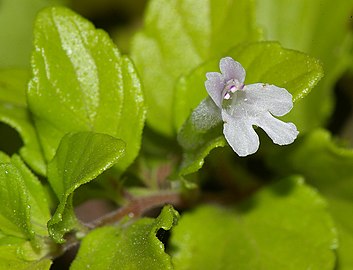Clinopodium douglasii
This article has multiple issues. Please help improve it or discuss these issues on the talk page. (Learn how and when to remove these messages)
|
| Clinopodium douglasii | |
|---|---|

| |
| Group of plants | |
| Scientific classification | |
| Kingdom: | Plantae |
| Clade: | Tracheophytes |
| Clade: | Angiosperms |
| Clade: | Eudicots |
| Clade: | Asterids |
| Order: | Lamiales |
| Family: | Lamiaceae |
| Genus: | Clinopodium |
| Species: | C. douglasii
|
| Binomial name | |
| Clinopodium douglasii | |
| Synonyms[1] | |
| |
Clinopodium douglasii, (synonym Micromeria douglasii),[1] yerba buena,[2] or Oregon tea[3] is a rambling aromatic herb of western and northwestern North America, ranging from maritime Alaska southwards to California.[4] The plant takes the form of a sprawling, mat-forming perennial, and is especially abundant close to the coast.[5] The name "yerba buena" derives from Spanish for "good herb" and is applied to various other plants. In 2010, molecular evidence placed the species within the Clinopodium complex rather than Micromeria.[6] As of November 2024[update], Plants of the World Online continued to place the species in the genus Micromeria,[1] though databases such as the Jepson Herbarium eFlora,[2] iNaturalist,[7] Calflora,[8] and the USDA PLANTS Database[9] place the species in Clinopodium.
The plant has a fragrance similar to spearmint. It was used by many groups of indigenous peoples of California as a beverage and a medicine, and was similarly used by later Spanish, Mexican, and American settlers.[citation needed] The Pomo people of Potter Valley northeast California infuse its leaves (called ma ca kau') for a kind of tea beverage.[10]
Name
[edit]The plant's most common name, "yerba buena", the same in English and Spanish, is an alternate form of the Spanish hierba buena (meaning "good herb"). Yerba buena is also used as a common name for other plants with aromatic foliage and in particular, for various old world mints.
Association with San Francisco
[edit]The name yerba buena was bestowed by Catholic missionaries of Alta California after native people introduced them to it. It was so abundant there that its name was also applied to the settler's town adjacent to Mission San Francisco de Asís as well as to the cove along San Francisco Bay upon which it was situated. The prominent island directly in front of the settlement also came to be called Isla Yerba Buena (now Yerba Buena Island) at least as early as 1833,[11] although it is not certain whether it was named for the settlement, the cove or directly for the herb. In 1846, the town of Yerba Buena was seized by the United States during the Mexican–American War. Its name was changed in 1847 to San Francisco. Nevertheless, many features in and near San Francisco, such as the Yerba Buena Center for the Arts and Yerba Buena Gardens, take their name from the prior name for San Francisco.
See also
[edit]References
[edit]- ^ a b c "Micromeria douglasii Benth." Plants of the World Online. Royal Botanic Gardens, Kew. Retrieved 2023-05-16.
- ^ a b Online link to The Jepson Manual eFlora = http://ucjeps.berkeley.edu/eflora/eflora_display.php?tid=80483 accessed 09 March 2016
- ^ Oregon Flora: Clinopodium douglasii (Benth.) Kuntze
- ^ "PLANTS Profile for Clinopodium douglasii (yerba buena)". NRCS PLANTS database. United States Department of Agriculture (USDA). Retrieved 2024-11-09.
- ^ Wood, Michael (2003-09-01). "Focus on Rarities, Yerba Buena Chapter, CNPS (Satureja douglasii)". CNPS Yerba Buena Chapter website. California Native Plant Society. Archived from the original on July 31, 2017. Retrieved 2007-12-19.
Website structure requires navigation to the linked index page and then selection of the 'Yerba buena' article
- ^ Bräuchler, C, et al. Mol Phylogenet Evol. 2010 May;55(2):501-23 Molecular phylogeny of Menthinae (Lamiaceae, Nepetoideae, Mentheae) --Taxonomy, biogeography and conflicts
- ^ iNaturalist: Yerba Buena (Clinopodium douglasii)
- ^ Clinopodium douglasii (Benth.) Kuntze
- ^ United States Department of Agriculture PLANTS Database, Plant Profile: Clinopodium douglasii (Benth.) Kuntze
- ^ Welch, James R. (2013). Sprouting Valley: Historical Ethnobotany of the Northern Pomo from Potter Valley, California. Society of Ethnobiology. p. 63. ISBN 978-0-9887330-2-2.
- ^ The Harbour of San Francisco, Nueva California. Views: The Entrance to San Francisco Harbour, Beechey, Frederick William, Hydrographical Office of the Admiralty, London, 1833
External links
[edit]- Clinopodium
- Flora of the Southwestern United States
- Flora of California
- Flora of the Northwestern United States
- Flora of Oregon
- Flora of Washington (state)
- Flora of Western Canada
- Natural history of the California chaparral and woodlands
- Natural history of the California Coast Ranges
- Natural history of San Francisco
- Plants described in 1831
- Taxa named by George Bentham
- Herbs
- Herbal teas


